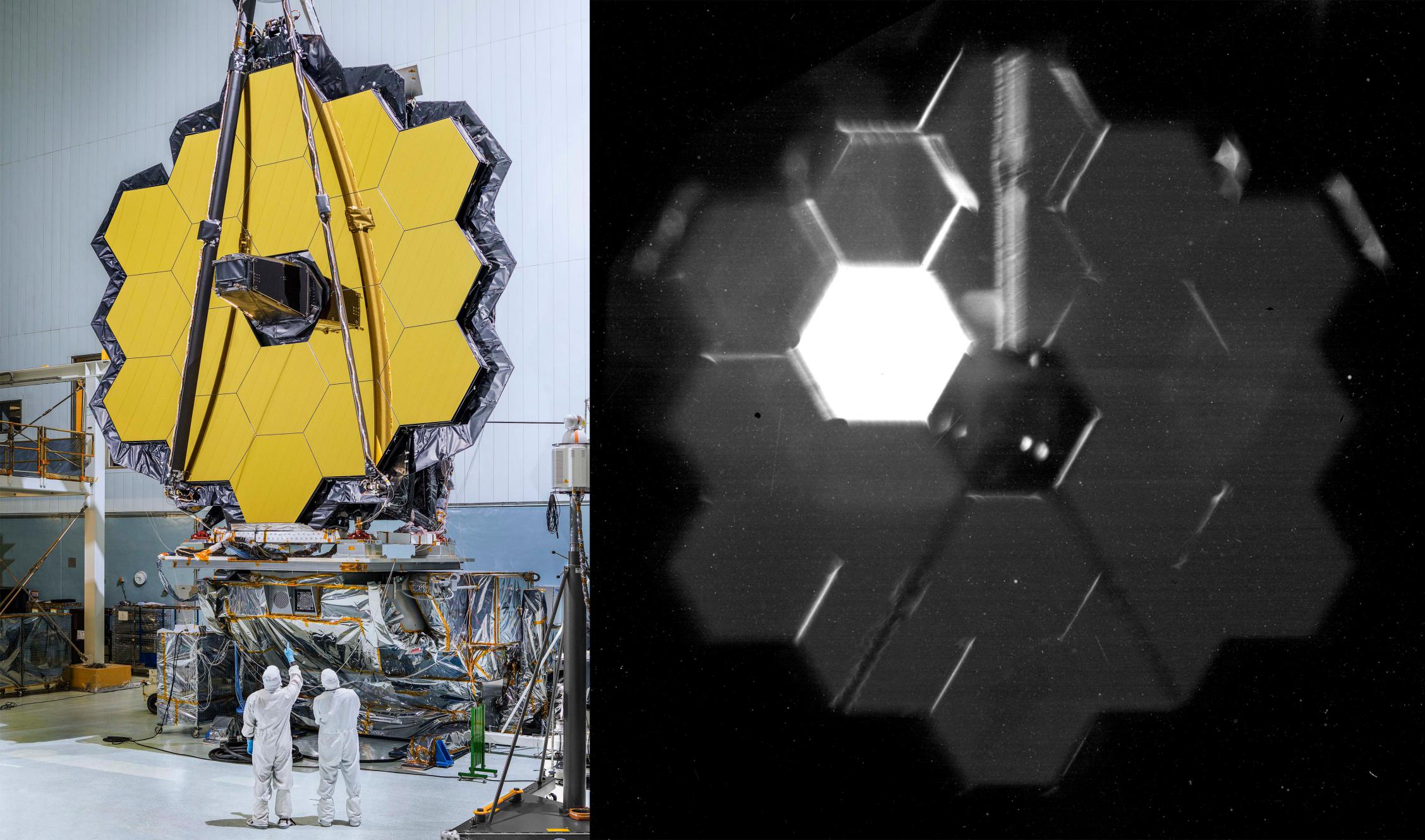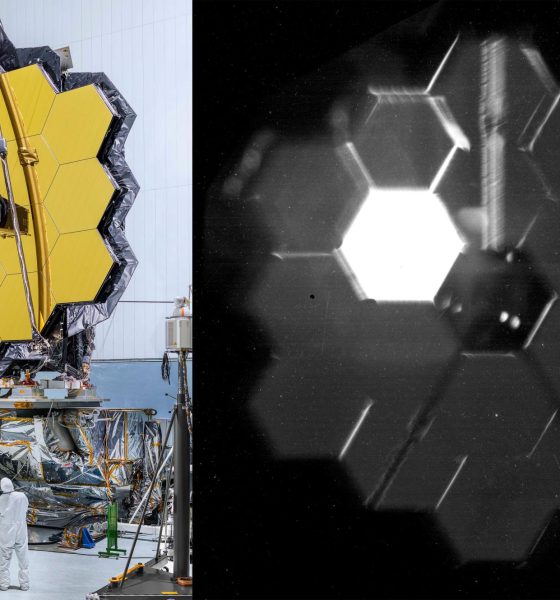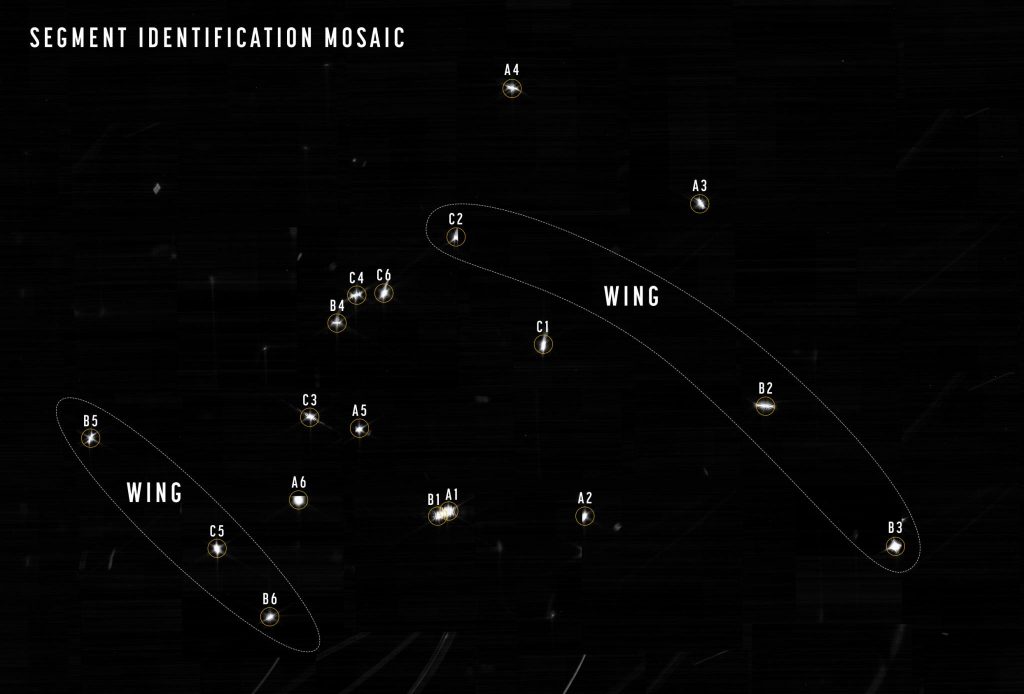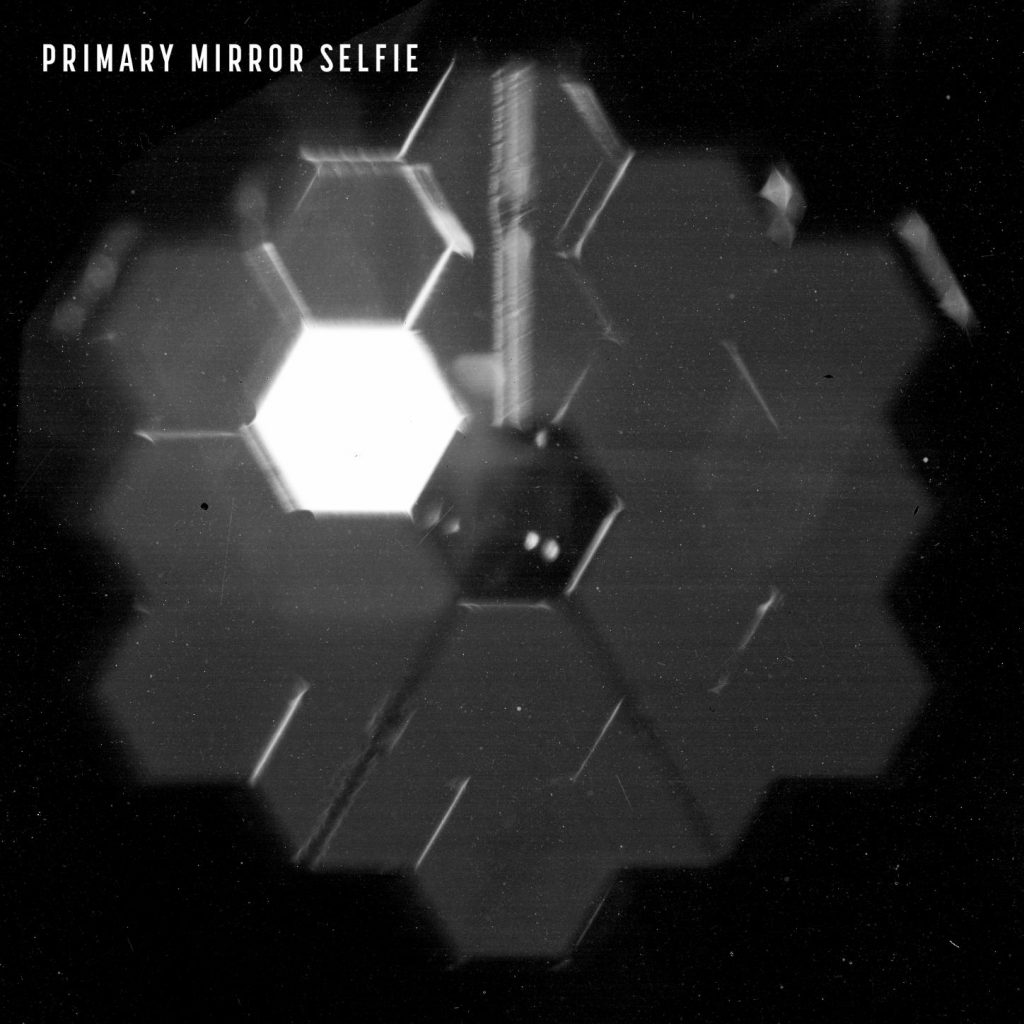

News
NASA’s James Webb Space Telescope is beginning to come to life in deep space
NASA has published some of the first recognizable photos taken by the James Webb Space Telescope (JWST), the most capable space telescope ever created.
On December 25th, 2021, the James Webb Space Telescope launched into orbit from South America’s Kourou, French Guiana spaceport, catching a ride on a European Ariane 5 rocket. After a 30-day voyage from the launch pad to an operational orbit approximately 1 million miles from Earth; weeks of maneuvering, orienting, and deploying hundreds of mechanical parts, the telescope has finally unveiled its first images from space – including an unexpectedly recognizable view of its vast primary mirror.
The array of images show a nondescript star (HD 84406) in the constellation Ursa Major that was chosen to support JWST calibration mainly because of how dim it is. Each image is created from light reflecting from each of Webb’s 18 main mirror segments, which together make up the 6.5-meter-wide (21 ft) primary mirror of the telescope. In this instance, those images were reflected into a secondary mirror and then recorded by the Near Infrared Camera (NIRCAM). Eventually, if all goes well during the lengthy calibration and commissioning process, all 18 mirror segments will be aligned to the level of individual wavelengths of light (nanometer precision) and focused until all 18 photos of star HD 84406 become one. Finally, each of the telescopes many complex instruments must also be calibrated.

Image capture operations started on February 2nd. Webb was repositioned 156 times to properly capture images of HD 84406 and after 25 hours, JWST was able to locate the star within all 18 mirror segments and generated 1,560 images using NIRCam’s 10 detectors, amounting to 54 gigabytes of raw data.
“This initial search covered an area about the size of the full Moon because the segment dots could potentially have been that spread out on the sky,” said Marshall Perrin, deputy telescope scientist for Webb and an astronomer at the Space Telescope Science Institute. “Taking so much data right on the first day required all of Webb’s science operations and data processing systems here on Earth working smoothly with the observatory in space right from the start. And we found light from all 18 segments very near the center early in that search! This is a great starting point for mirror alignment.”
Additionally, NASA shared an unexpected, ghostly “selfie” that the observatory took of its primary mirror array with a crucial instrument known as NIRCAM (short for Near-Infrared Camera).

“Moving forward, Webb’s images will only become clearer, more detail-laden, and more intricate as its other three instruments arrive at their intended cryogenic operating temperatures and begin capturing data. The first scientific images are expected to be delivered to the world in the summer of 2022. Though this is a big moment, confirming that Webb is a functional telescope, there is much ahead to be done in the coming months to prepare the observatory for full scientific operations using all four of its instruments.” (NASA)
Because Webb prioritizes weak infrared wavelengths of light to detect extraordinarily distant objects in our universe, the entire business side of the telescope – included all mirrors, sensors, and most instruments – must be kept incredibly cold – closer to absolute zero than any temperature humans are familiar with. The telescope uses a tennis-court-sized multilayer sun shield to protect itself from the heat of the sun, which it must be constantly exposed to in order to power itself with solar arrays. The outermost layer will always face the Sun and reflect most of its heat, operating at a scorching 230 degrees Fahrenheit. But each layer of the shield will become cooler and cooler so that JWST’s instruments stay cryogenic, operating around -370 degrees Fahrenheit.
The James Webb Space Telescope is the world’s largest, most powerful, and most complex space-based observatory ever built. If commissioning ends as successfully as launch, deployment, and early alignment, Webb will one day help solve mysteries of our own solar system, look beyond to distant worlds around other stars, and probe the mysterious structures and origins of our universe. Webb is an international program led (and mostly funded) by NASA alongside partners ESA (European Space Agency) and CSA (Canadian Space Agency).

Elon Musk
Elon Musk’s X will start using a Tesla-like software update strategy
The initiative seems designed to accelerate updates to the social media platform, while maintaining maximum transparency.

Elon Musk’s social media platform X will adopt a Tesla-esque approach to software updates for its algorithm.
The initiative seems designed to accelerate updates to the social media platform, while maintaining maximum transparency.
X’s updates to its updates
As per Musk in a post on X, the social media company will be making a new algorithm to determine what organic and advertising posts are recommended to users. These updates would then be repeated every four weeks.
“We will make the new 𝕏 algorithm, including all code used to determine what organic and advertising posts are recommended to users, open source in 7 days. This will be repeated every 4 weeks, with comprehensive developer notes, to help you understand what changed,” Musk wrote in his post.
The initiative somewhat mirrors Tesla’s over-the-air update model, where vehicle software is regularly refined and pushed to users with detailed release notes. This should allow users to better understand the details of X’s every update and foster a healthy feedback loop for the social media platform.
xAI and X
X, formerly Twitter, has been acquired by Elon Musk’s artificial intelligence startup, xAI last year. Since then, xAI has seen a rapid rise in valuation. Following the company’s the company’s upsized $20 billion Series E funding round, estimates now suggest that xAI is worth tens about $230 to $235 billion. That’s several times larger than Tesla when Elon Musk received his controversial 2018 CEO Performance Award.
As per xAI, the Series E funding round attracted a diverse group of investors, including Valor Equity Partners, Stepstone Group, Fidelity Management & Research Company, Qatar Investment Authority, MGX, and Baron Capital Group, among others. Strategic partners NVIDIA and Cisco Investments also continued support for building the world’s largest GPU clusters.
News
Tesla FSD Supervised wins MotorTrend’s Best Driver Assistance Award
The decision marks a notable reversal for the publication from prior years, with judges citing major real-world improvements that pushed Tesla’s latest FSD software ahead of every competing ADAS system.

Tesla’s Full Self-Driving (Supervised) system has been named the best driver-assistance technology on the market, earning top honors at the 2026 MotorTrend Best Tech Awards.
The decision marks a notable reversal for the publication from prior years, with judges citing major real-world improvements that pushed Tesla’s latest FSD software ahead of every competing ADAS system. And it wasn’t even close.
MotorTrend reverses course
MotorTrend awarded Tesla FSD (Supervised) its 2026 Best Tech Driver Assistance title after extensive testing of the latest v14 software. The publication acknowledged that it had previously criticized earlier versions of FSD for erratic behavior and near-miss incidents, ultimately favoring rivals such as GM’s Super Cruise in earlier evaluations.
According to MotorTrend, the newest iteration of FSD resolved many of those shortcomings. Testers said v14 showed far smoother behavior in complex urban scenarios, including unprotected left turns, traffic circles, emergency vehicles, and dense city streets. While the system still requires constant driver supervision, judges concluded that no other advanced driver-assistance system currently matches its breadth of capability.
Unlike rival systems that rely on combinations of cameras, radar, lidar, and mapped highways, Tesla’s FSD operates using a camera-only approach and is capable of driving on city streets, rural roads, and freeways. MotorTrend stated that pure utility, the ability to handle nearly all road types, ultimately separated FSD from competitors like Ford BlueCruise, GM Super Cruise, and BMW’s Highway Assistant.
High cost and high capability
MotorTrend also addressed FSD’s pricing, which remains significantly higher than rival systems. Tesla currently charges $8,000 for a one-time purchase or $99 per month for a subscription, compared with far lower upfront and subscription costs from other automakers. The publication noted that the premium is justified given FSD’s unmatched scope and continuous software evolution.
Safety remained a central focus of the evaluation. While testers reported collision-free operation over thousands of miles, they noted ongoing concerns around FSD’s configurable driving modes, including options that allow aggressive driving and speeds beyond posted limits. MotorTrend emphasized that, like all Level 2 systems, FSD still depends on a fully attentive human driver at all times.
Despite those caveats, the publication concluded that Tesla’s rapid software progress fundamentally reshaped the competitive landscape. For drivers seeking the most capable hands-on driver-assistance system available today, MotorTrend concluded Tesla FSD (Supervised) now stands alone at the top.
News
Elon Musk’s Grokipedia surges to 5.6M articles, almost 79% of English Wikipedia
The explosive growth marks a major milestone for the AI-powered online encyclopedia, which was launched by Elon Musk’s xAI just months ago.

Elon Musk’s Grokipedia has grown to an impressive 5,615,201 articles as of today, closing in on 79% of the English Wikipedia’s current total of 7,119,376 articles.
The explosive growth marks a major milestone for the AI-powered online encyclopedia, which was launched by Elon Musk’s xAI just months ago. Needless to say, it would only be a matter of time before Grokipedia exceeds English Wikipedia in sheer volume.
Grokipedia’s rapid growth
xAI’s vision for Grokipedia emphasizes neutrality, while Grok’s reasoning capabilities allow for fast drafting and fact-checking. When Elon Musk announced the initiative in late September 2025, he noted that Grokipedia would be an improvement to Wikipedia because it would be designed to avoid bias.
At the time, Musk noted that Grokipedia “is a necessary step towards the xAI goal of understanding the Universe.”
Grokipedia was launched in late October, and while xAI was careful to list it only as Version 0.1 at the time, the online encyclopedia immediately earned praise. Wikipedia co-founder Larry Sanger highlighted the project’s innovative approach, noting how it leverages AI to fill knowledge gaps and enable rapid updates. Netizens also observed how Grokipedia tends to present articles in a more objective manner compared to Wikipedia, which is edited by humans.
Elon Musk’s ambitious plans
With 5,615,201 total articles, Grokipedia has now grown to almost 79% of English Wikipedia’s article base. This is incredibly quick, though Grokipedia remains text-only for now. xAI, for its part, has now updated the online encyclopedia’s iteration to v0.2.
Elon Musk has shared bold ideas for Grokipedia, including sending a record of the entire knowledge base to space as part of xAI’s mission to preserve and expand human understanding. At some point, Musk stated that Grokipedia will be renamed to Encyclopedia Galactica, and it will be sent to the cosmos.
“When Grokipedia is good enough (long way to go), we will change the name to Encyclopedia Galactica. It will be an open source distillation of all knowledge, including audio, images and video. Join xAI to help build the sci-fi version of the Library of Alexandria!” Musk wrote, adding in a later post that “Copies will be etched in stone and sent to the Moon, Mars and beyond. This time, it will not be lost.”








